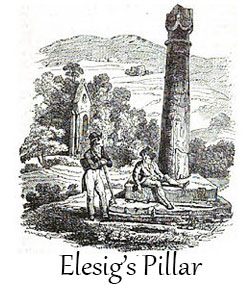|
The Roman conquest of Wales began in AD 48 and was completed in 78, with Roman rule lasting until 383. Roman rule in Wales was a military occupation, save for the southern coastal region of South Wales east of the Gower Peninsula, where there is a legacy of Romanisation. The only town in Wales founded by the Romans, Caerwent, is located in South Wales. Both Caerwent and Carmarthen, also in southern Wales, would become Roman civitates. During the occupation both the region that would become Wales and its people were a mostly anonymous part of Roman Britain.
By AD 47 Rome had invaded and conquered all of southernmost and southeastern Britain under the first Roman governor of Britain. As part of the Roman conquest of Britain, a series of campaigns to conquer Wales was launched by his successor in 48 and would continue intermittently under successive governors until the conquest was completed in 78. It is these campaigns of conquest that are the most widely known feature of Wales during the Roman era due to the spirited but unsuccessful defence of their homelands by two native tribes, the Silures and the Ordovices.
The Demetae of southwestern Wales seem to have quickly made their peace with the Romans, as there is no indication of war with Rome, and their homeland was not heavily planted with forts nor overlaid with roads. The Demetae would be the only Welsh tribe to emerge from Roman rule with their homeland and tribal name intact.
Wales was a rich source of mineral wealth and the Romans used their engineering technology to extract large amounts of gold, copper, and lead, as well as modest amounts of some other metals such as zinc and silver. When the mines were no longer practical or profitable, they were abandoned. Roman economic development was concentrated in southeastern Britain, with no significant industries located in Wales. This was largely a matter of circumstance, as Wales had none of the needed materials in suitable combination, and the forested, mountainous countryside was not amenable to industrialisation.
The year 383 denotes a significant point in Welsh history, remembered in literature and considered to be the foundation point of several medieval royal dynasties. In that year the Roman general Magnus Maximus would strip all of western and northern Britain of troops and senior administrators and launch a successful bid for imperial power, continuing to rule Britain from Gaul as emperor. Having left with the troops and Roman administrators, and planning to continue as the ruler of Britain in the future, his practical course was to transfer local authority to local rulers. Welsh legend provides a mythic story that says he did exactly that.
The Dream of Maxen Wledig
In the story of Breuddwyd Macsen Wledig (English: The Dream of Emperor Maximus),  he is Emperor of Rome and marries a wondrous British woman, telling her that she may name her desires, to be received as a wedding portion. She asks that her father be given sovereignty over Britain, thus formalising the transfer of authority from Rome back to the Britons themselves. The marriage also makes possible British descendants, a point not lost on medieval kings. The earliest Welsh genealogies give Maximus the role of founding father for several royal dynasties, including those of Powys and Gwent, a role he also played for the rulers of medieval Galloway in Scotland, home to the Roman-era Novantae whose territory was also made independent of Roman rule by Maximus. He is given as the ancestor of a Welsh king on the Pillar of Eliseg, (right) erected nearly 500 years after he left Britain, and he figures in lists of the Fifteen Tribes of Wales. he is Emperor of Rome and marries a wondrous British woman, telling her that she may name her desires, to be received as a wedding portion. She asks that her father be given sovereignty over Britain, thus formalising the transfer of authority from Rome back to the Britons themselves. The marriage also makes possible British descendants, a point not lost on medieval kings. The earliest Welsh genealogies give Maximus the role of founding father for several royal dynasties, including those of Powys and Gwent, a role he also played for the rulers of medieval Galloway in Scotland, home to the Roman-era Novantae whose territory was also made independent of Roman rule by Maximus. He is given as the ancestor of a Welsh king on the Pillar of Eliseg, (right) erected nearly 500 years after he left Britain, and he figures in lists of the Fifteen Tribes of Wales.
Tradition holds that following the Roman departure, Roman customs held on into the 5th century in southern Wales, and that is true in part. Caerwent continued to be occupied, while Carmarthen was probably abandoned in the late 4th century. In addition, southwestern Wales was the tribal territory of the Demetae, who had never become thoroughly Romanised. An influx of settlers from southeastern Ireland had taken place in the late 4th century, both in northern Wales and in the entire region of southernmost and southwestern Wales under circumstances that are still poorly understood, and it seems far-fetched to suggest that they were ever Romanised.
Indeed, aside from the many Roman-related finds along the southern coast and the fully romanised area around Caerwent, Roman archaeological remains in Wales consist almost entirely of military roads and fortifications.
|

